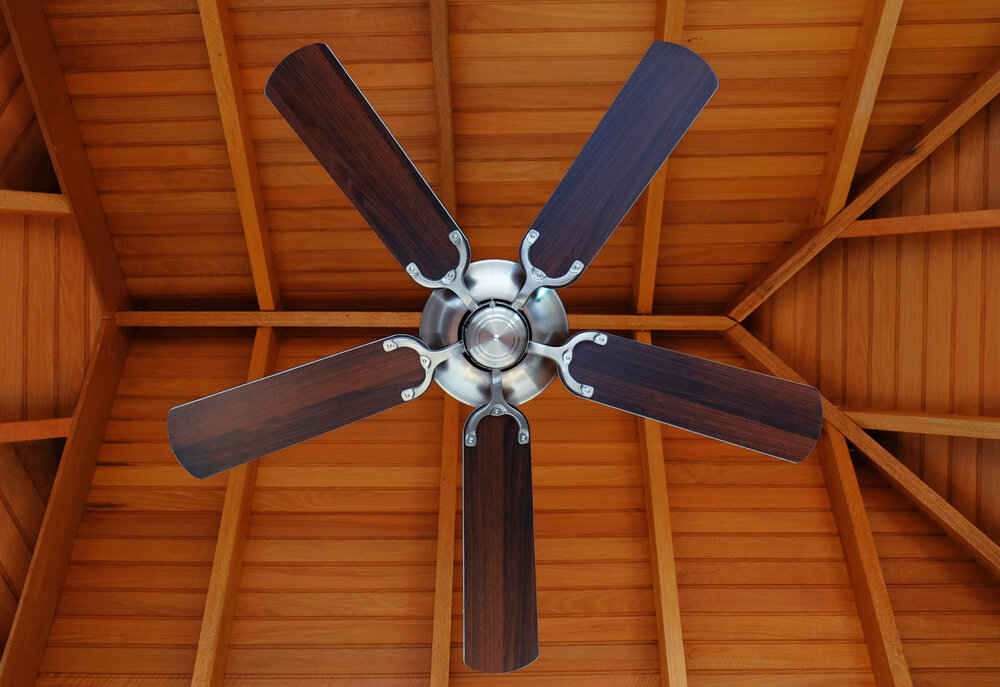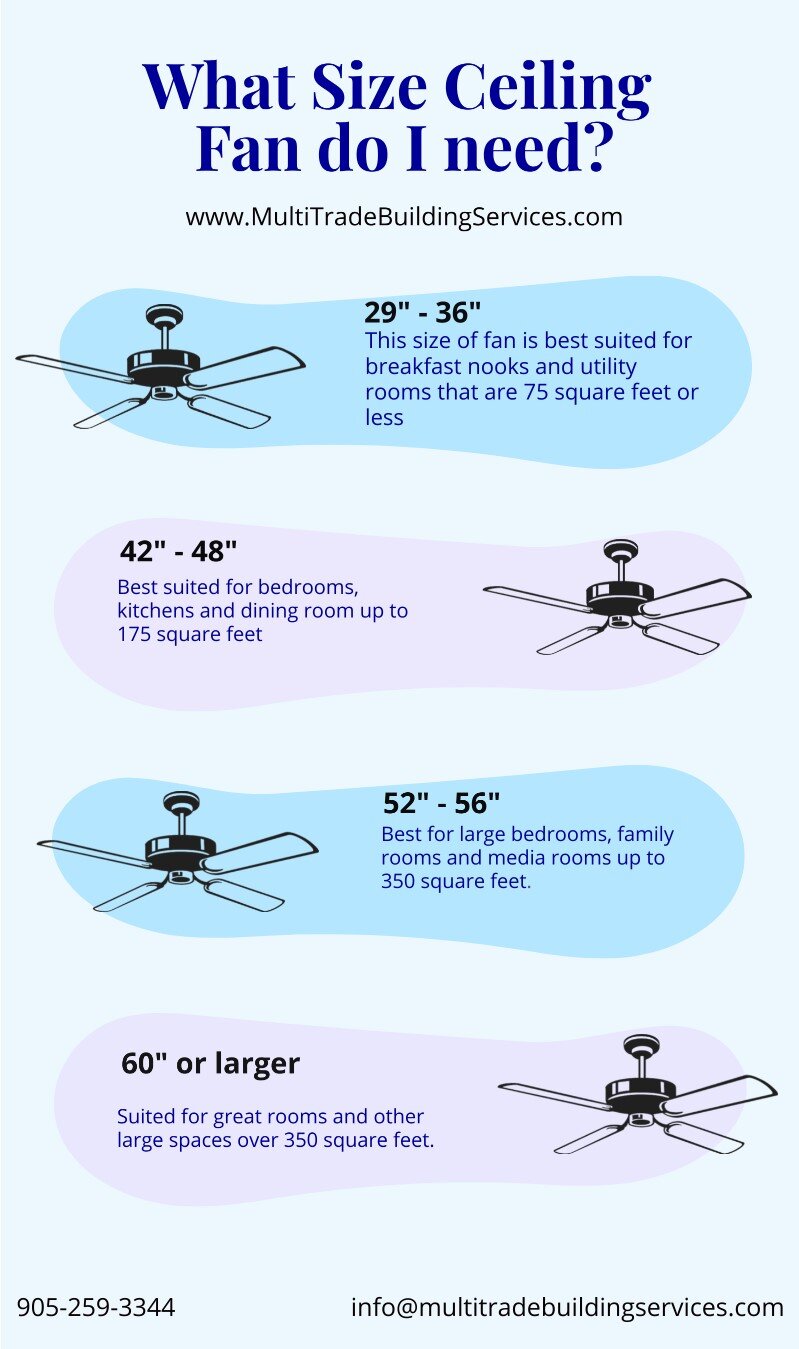Ceiling Fans: Why You Should Consider One (Or More) For Your Home
/If there was one item that could make you more comfortable, lower your heating and cooling bills, produce some extra lighting, and make your room more stylish, you'd want to know more about it, right? What if I told you that item is a simple, affordable ceiling fan? In this post, we talk about ceiling fans and why you should consider having one in almost every room in your home.
Prefer to listen?
History of Ceiling Fans
It's hard to believe, but ceiling fans were invented in the 1880s. They were invented by Philip Diehl, who also engineered the electric motor used in the first electrically powered Singer sewing machines. He adapted that motor to create the first ceiling-mounted fan.
Over the 20th century, they became more widely used in homes but lost popularity in the 1950s with the invention of the air conditioner. They gained popularity again in the 1970s during the energy crisis.
Looking to install a ceiling fan in your home? Click here to book your in home quotation
Benefits of Ceiling Fans
There are so many benefits to ceiling fans, both in terms of comfort and cost savings.
They lower the ambient temperature in the summer
No matter what the circumstances, ceiling fans will lower the temperature in a room by 4 or 5 degrees. Whether it's a small or large room, one with windows or without, the temperature of the room will be lower. This means that if you don't have air conditioning, the room will be more comfortable. If you have windows open, the air will circulate better, and the room will be cooler. If you have the air conditioning on, it will still make the room cooler, which means you could turn your A/C temperature up a bit to compensate. This results in cost savings.
They raise the temperature in the winter
If you reverse the direction the blades spin in the winter (clockwise in the winter and counterclockwise in the summer), ceiling fans will heat the air in the room. By spinning in a clockwise direction, a ceiling fan will pull the air up toward the ceiling and distribute the warm air more evenly. Because your rooms will feel warmer, you can turn down the temperature of the furnace for cost savings.
Ceiling fans are inexpensive to operate
Ceiling fans typically only cost pennies per day to operate. For a miniscule amount of cost, the savings over the long haul far outweigh the minimal cost.
Ceiling fans have become a stylish part of a home's decor. You can purchase a simple ceiling fan with 4 or 5 blades, or you can get one with lights, remotes, or chandelier types. There are so many styles to select from that you'll easily find one that suits the decor in your home.
If the budget allows, we always recommend purchasing one with a light. It never hurts to have the added feature of some extra light in the room. Here's a link to a gorgeous matte black ceiling fan with lights from Home Depot. For only $149, it comes with an LED light and a remote.
You can even get a ceiling fan for the great outdoors!
Ceiling fans are one of the only ways to reduce the temperature in an outdoor or semi-outdoor space. Installing a ceiling fan on a deck, sunroom, porch, patio, or outdoor kitchen can push the cool air down, circulating the air and cooling the skin. Because the air is moving, it may also help drive the insects away!
Cons of Ceiling Fans
I would be remiss if I didn't point out some of the Cons of ceiling fans as well.
They can be noisy
If ceiling fans aren't perfectly balanced and clean, they can be noisy. Over time, the weight can shift, the blades will move, and the screws will come loose. This is easy enough to rectify by carefully checking and cleaning your ceiling fan regularly. Barring that, a Licensed Electrician and some skilled handymen can rebalance your ceiling fan fairly quickly. They even sell ceiling fan balancing kits to make the job easier.
Cleaning them can be a challenge
Depending on how high the ceiling is, it can be difficult to clean your ceiling fan. There are special wand cleaning tools available that make cleaning the top of your blades relatively easy. Personally, I only have 8' ceilings in my home, so I just use a step stool, and the job is done quickly and easily.
However, if your ceilings are 10 feet or higher, getting to the ceiling fan to clean it or even replace a bulb can be a real challenge.
Not the best options for really tall people and short ceilings
If you're 6'4" and you have 8' ceilings, you may not want to install too many ceiling fans. There are ceiling hugger fans available, and those might work for you. Talk to an electrician before purchasing your fan.
If you still want the benefit of ceiling fans and you have a lot of tall people living in your home, consider installing them in areas where you won't walk into them. For example, centre the fan over your bed. You'll still reap the benefits but likely won't hit your head on the fan blades.
So where should I install a ceiling fan?
My best recommendation: if your budget allows, put one in every room! You don't need ceiling fans in your bathrooms, as you should already have exhaust fans in those rooms.
Your top priority rooms should be bedrooms, family rooms, and living rooms. These are places where you spend a lot of time. Most people don't put them in their kitchens, but the kitchen is usually one of the hottest places in your home. Installing a ceiling fan in the kitchen can circulate the air and help reduce the heat in the summer when your stove and/or oven are on.
Although not an absolute necessity, ceiling fans in the basement can help the most in the winter months, when basements tend to be a bit colder. If your basement was professionally and properly finished, it shouldn't feel too much different (temperature-wise) than the rest of your home. Therefore, you could use a ceiling fan in your basement year-round and reap the benefits from it.
How to select the right ceiling fan
Bigger isn't always better. You need to ensure you pick the right-sized ceiling fan for the size of the room you are putting it in. You need to consider the square footage, dimensions, and shape of the room, as well as the height of the ceiling.
Check out the chart to get an idea of what size fan you need.
You can tell how good the fan is by the rating
Most ceiling fans today are rated based on their efficacy. Efficacy is an efficiency rating where the output and input quantities have different units. For fans, the measure of efficacy is how much air flow you get for the amount of electrical energy you put in. Its units are cubic feet per minute (cfm) of air flow per watt (W) of electrical power. A good fan will give you more than 100 cfm per watt; a poor one might be as low as 30 cfm per watt. If it has an Energy Star rating, you know it's an efficient model.
To sum up...
Ceiling fans are highly recommended for homes with ceilings that are at least 8 feet tall. Make sure you purchase a fan with a reversible motor so you can switch the way the blades spin for the winter and the summer. Pick up one with an Energy Star rating for the greatest efficiency.
Check to see if the fan blades are interchangeable. If you tire of the look of your fan, being able to switch out the blades is a lot easier and cheaper than having to replace the whole unit. If you already have a fan but it doesn't have a light, check to see if a light kit is available for your model of fan. Start today by evaluating where you could best use a ceiling fan in your home!























